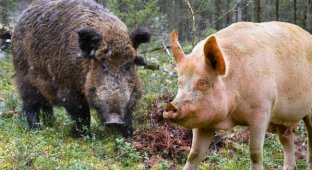Wasabi is a perennial plant native to Japan, where it can be grown throughout the year. Most of the most valuable wasabi root is grown in Japan on the Izu Peninsula, where, thanks to the mild climate and abundant rains, nature itself has created ideal conditions for its prosperous existence.

Wasabi, or Eutrema japonica, is a species of perennial herbaceous plants of the genus Eutrema of the Brassicaceae family. The seasoning made from its rhizome is called wasabi and is used in Japanese cuisine. The plant is known as "Japanese horseradish", but is not actually horseradish, although it is related to it (both genera belong to the same family).
Wasabi grows along the banks of mountain rivers. The cultivation of this plant began in the 10th century. There are two agricultural techniques: growing in cold mountain water in a semi-submerged state (hon-wasabi) and in the garden. The second variety is considered to be of lower quality; hon-wasabi has a brighter taste.

Wasabi is considered one of the most difficult plants to grow and care for. The culture is very demanding on the environment, temperature and humidity. It takes two years for the harvest to mature.
Thousands of farmers around the world have tried to grow this plant, but almost all have failed. The reason is simple: as stated above, most experts consider wasabi to be the most difficult plant in the world to grow commercially.

Wasabi seeds are very finicky. They germinate only at temperatures from +3 to +5°C. Before sowing, they are placed in the refrigerator. Young plants spend the first few months of their lives in special nurseries and only then move to the beds. Seedlings are grown in separate pots with specially prepared soil.
Young wasabi are planted on clean pebbles, thoroughly washed with water. The roots of the plant grow between the stones, and water flows inside and allows them to grow. Since wasabi has high requirements for water purity and water temperature, the Japanese grow this crop in mountainous areas

Preparing pebble soil takes a lot of time. First, the pebbles are stirred and turned over with a mini tractor.

Then weeds and other evil spirits (slugs, beetles) are burned out with special burners.

Then the made beds are washed with clean running water and voila - seedlings can be planted.
A small hole is made with a spatula and the roots of the plant are sprinkled with clean pebbles.

Ready beds.

This plant does best in a humid and warm climate (temperatures from 7 to 21 degrees Celsius). Wasabi cannot grow in full sun - it needs shade. You have to cover the beds with fabric to prevent the plant from overheating.

The characteristic rich taste of wasabi appears only after 24 months. During this time, the plant will reach 60 centimeters in height.

The harvest is coming. Wasabi is harvested by hand.


Harvested and processed wasabi roots.

Wasabi at a Japanese market. Wasabi is one of the traditional Japanese seasonings, originally known as medicinal wild ginger. Today, wasabi is an essential component of Japanese food culture, just like sushi or soba (buckwheat noodles).

Wasabi is one of the main ingredients in Japanese cuisine due to its unique subtle pungent taste and pleasant fresh aroma. Green paste, which is always served in Japanese cuisine with sushi or sashimi, can be prepared exclusively from grated wasabi rhizome or with the addition of other hot seasoning or mayonnaise. Japanese horseradish is also added to other dishes made with raw fish and to traditional buckwheat soba noodles. Its intense flavor is ideal for a variety of meat dishes or eggs, and is what makes wasabi an interesting oriental equivalent to ordinary white horseradish. It can be added to various types of marinades or sauces - both cold and hot. It is also an excellent ingredient for numerous soups or raw vegetable salads. Even a small amount of this green seasoning gives dishes an exceptional, intriguing taste and delights all lovers of spicy cuisine.

You can only grate wasabi using a shark skin grater.

According to Japanese culinary experts, a metal grater kills the taste of wasabi. You can't do that

Being one of the most expensive and hottest condiments in the world, wasabi not only has exceptional taste but also has many health benefits. Wasabi's unique flavor comes from the presence of isothiocyanates (ITCs), ethereal compounds with antibacterial properties that are released from glucosinolate precursors by the enzyme myrosinase when tissue is broken down. The ITC found in wasabi is volatile, has a strong pungent odor, and is toxic at high doses. The overall flavor of wasabi depends on the individual ITC content.
Wasabi isothiocyanates have powerful anti-cancer effects and also help fight inflammatory diseases such as asthma and anaphylaxis. ITCs have been shown to inhibit platelet aggregation in the blood, improving blood flow. In addition, these compounds effectively destroy 25 types of fungi, mold, E. coli and other bacteria. The presence of antimicrobial properties explains the popularity of using this seasoning in dishes with raw fish.
100 g of wasabi contains only 109 kcal, 23.54 g of carbohydrates, 0.63 g of fat, 4.8 g of protein.
The chemical composition of wasabi contains fiber, carbohydrates, natural fats, amino acids, vitamins A, groups B, C; minerals: zinc, sodium, phosphorus, manganese, potassium, copper, iron, calcium, magnesium.
The healing properties of wasabi root are used in the spa industry. Body wraps and scrubs with wasabi extracts help cleanse and rejuvenate the skin and eliminate cellulite. Wasabi extract is an excellent component in deodorants, body masks, as well as shampoos and hair foams.

Wasabi blossoms are as beautiful as cherry blossoms.
Eat wasabi and be healthy!





















